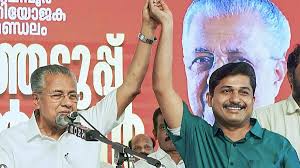Five Assembly bypolls in four states today: What is at stake for key players

On June 19, 2025, five assembly constituencies across Kerala, Punjab, Gujarat, and West Bengal are witnessing closely watched by-elections. Though these are local contests, their political significance is national. For both ruling parties and opposition forces, these bypolls offer a crucial litmus test.
1. Nilambur (Kerala): Legacy Clash Between CPI(M) and Congress
In Kerala’s Nilambur seat, the battle reflects the broader rivalry between the CPI(M) and the Congress within the INDIA bloc. This constituency became vacant after PV Anvar, an independent MLA backed by the CPI(M), resigned and decided to contest again independently.
The CPI(M) has chosen M. Swaraj, a former legislator and staunch party loyalist, to contest. Swaraj, backed strongly by Chief Minister Pinarayi Vijayan, represents the Left’s attempt to solidify its grip on northern Kerala.
Opposing him, Aryadan Shoukath of the Congress is trying to reclaim a seat his late father, Aryadan Mohammed, won multiple times. This makes the election not only a political contest but also a personal legacy battle.
Meanwhile, PV Anvar’s independent candidacy adds a third dimension, making this contest more unpredictable.
Why It Matters:
A win for CPI(M) would reaffirm its dominance ahead of the 2026 Assembly polls. On the other hand, a Congress victory would rejuvenate the party’s ground-level momentum. Transitioning leadership from father to son could emotionally resonate with voters.
2. Kaliganj (West Bengal): TMC Banks on Sympathy and Identity
In West Bengal, the Kaliganj bypoll emerged after the death of TMC MLA Nasiruddin Ahmed. His daughter, Alifa Ahmed, is now running on the TMC ticket. Her candidacy appeals to both emotion and identity—especially among women and Muslim voters.
The BJP has fielded Ashish Ghosh, aiming to benefit from communal polarization and a strong anti-incumbency mood. Simultaneously, the Congress-Left alliance has backed Kabil Uddin Sheikh, hoping to regain lost ground in Murshidabad.
Recent communal tensions in the district have fueled heated rhetoric from all sides. As a result, voter turnout could become a determining factor.
Why It Matters:
If the TMC retains Kaliganj, it will further assert its supremacy in rural Bengal. Alternatively, a loss could signal weakening minority support or growing opposition unity—key concerns with the 2026 Assembly election looming.
3. Ludhiana West (Punjab): AAP’s Popularity on Trial
In Punjab, Ludhiana West is witnessing a four-way contest. The death of AAP MLA Gurpreet Bassi Gogi created a vacancy, and now the AAP has nominated Rajya Sabha MP Sanjeev Arora, a respected industrialist and clean-image candidate.
He faces Congress’s Bharat Bhushan Ashu, a seasoned politician with deep roots in Ludhiana. BJP’s Jiwan Gupta and SAD’s Parupkar Singh Ghumman are also in the fray, attempting to woo urban Sikh and Hindu voters.
So far, the campaign has focused on urban infrastructure, drug control, and youth employment. Moreover, the battle also reflects larger aspirations—AAP hopes to showcase Punjab as a model state under its rule.
Why It Matters:
If AAP wins, it will reaffirm urban voters’ trust. It could also open the door for strategic placements in the Rajya Sabha, especially for leaders like Kejriwal or Sisodia. On the contrary, a defeat could expose growing dissatisfaction in urban pockets.
4. Visavadar and Kadi (Gujarat): BJP Faces Real Challenges
In Gujarat, two key constituencies—Visavadar and Kadi—are witnessing triangular contests involving the BJP, Congress, and AAP.
In Visavadar, the AAP’s former MLA Bhupat Bhayani defected to the BJP. Now contesting under the BJP’s symbol, he faces criticism for party-hopping. Congress and AAP are banking on voter disillusionment to swing votes in their favor.
In Kadi, an SC-reserved seat, the contest follows the death of BJP MLA Karsan Solanki. All three major parties have deployed grassroots-level workers to mobilize Dalit votes.
Why It Matters:
Though Gujarat remains a BJP stronghold, these bypolls test the AAP’s expansion strategy and the Congress’s revival hopes. Any dent in BJP’s vote share will be keenly analyzed by party strategists ahead of future Lok Sabha elections.
The Bigger Picture
These bypolls are the first electoral event after the recent national security developments, including Operation Sindoor. They also serve as a post-Lok Sabha political pulse check.
For the NDA, these elections offer a chance to assert dominance. Meanwhile, the INDIA bloc will try to demonstrate cohesion and relevance at the state level.
Voter Turnout Snapshot (as of early afternoon):
- Nilambur (Kerala): ~46%
- Kaliganj (West Bengal): ~45%
- Visavadar (Gujarat): ~39%
- Kadi (Gujarat): ~34%
- Ludhiana West (Punjab): ~33%
The final turnout will play a major role in determining outcomes. Historically, lower turnouts tend to favor ruling parties.
Conclusion
Although these are individual bypolls, their outcomes could influence political discourse across the country. With high-profile candidates and legacy names in the fray, the results—due on June 23—will likely shape narratives for upcoming state elections.
These by-elections aren’t just about numbers—they’re about signaling strength, testing alliances, and preparing for the road ahead in Indian politics.






